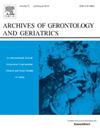社会孤立和孤独对老年人残疾发生率的综合影响。
IF 3.5
3区 医学
Q2 GERIATRICS & GERONTOLOGY
引用次数: 0
摘要
目的:社会孤立、孤独和残疾发病之间的关系尚不清楚。我们调查了经历社会孤立和孤独的日本老年人残疾发展的独特模式。设计:本研究采用前瞻性观察方法。参与者:分析了来自4,716名社区独居老年人的数据。测量方法:分别使用日本版加州大学洛杉矶分校孤独量表第3版和社会隔离量表来测量孤独和社会隔离。这家长期护理保险公司对参与者进行了为期两年的每月随访,以确定他们的护理需求。残疾开始被定义为参与者被护理经理证明需要长期护理的点。结果:在随访期间,265名参与者(5.6%)因残疾发作而需要长期护理保险证明。孤独组和不孤独组的残疾发生率分别为8.0%和4.5%。在社会孤立和非社会孤立的群体中,这一比例分别为7.1%和4.4%。Cox比例风险回归模型显示,孤独和社会孤立群体的残疾发生率显著较高。经历孤独和社会隔离的高风险组比没有这些症状的低风险组表现出明显更高的风险比。结论:社会孤立和孤独感并存的老年人未来残疾发生率较高。这一发现揭示了社会因素与残疾之间复杂的相互作用,有助于制定有效的干预措施,促进健康老龄化和预防残疾。本文章由计算机程序翻译,如有差异,请以英文原文为准。
Combined effects of social isolation and loneliness on disability incidence in older adults
Objectives
Relationships among social isolation, loneliness, and disability onset remain unclear. We investigated the distinct patterns of disability development among Japanese older adults who experience social isolation and loneliness.
Design
This study applied a prospective observational approach.
Participants
Data from 4,716 community-dwelling independent older adults were analyzed.
Measurements
The Japanese version of the University of California, Los Angeles Loneliness Scale Version 3 and the Social Isolation Scale were used to measure loneliness and social isolation, respectively. The long-term care insurer conducted monthly follow-ups with participants over two years to determine their care needs. Disability onset was defined as the point at which participants were certified by a care manager as requiring long-term care.
Results
During the follow-up period, 265 participants (5.6 %) required long-term care insurance certification due to disability onset. The incidence of disability in the lonely and not lonely groups was 8.0 % and 4.5 %, respectively. In the socially isolated and not socially isolated groups, it was 7.1 % and 4.4 %, respectively. The Cox proportional hazards regression model revealed a significantly higher risk of disability incidence in the lonely and socially isolated groups. The high-risk group experiencing both loneliness and social isolation exhibited significantly higher hazard ratios than the low-risk group without these symptoms.
Conclusions
The results indicated that older adults experiencing both social isolation and loneliness were at high-risk for future disability incidence. This finding provides insight into the complex interplay between social factors and disability, which can contribute to the development of effective interventions to promote healthy aging and prevent disability.
求助全文
通过发布文献求助,成功后即可免费获取论文全文。
去求助
来源期刊
CiteScore
7.30
自引率
5.00%
发文量
198
审稿时长
16 days
期刊介绍:
Archives of Gerontology and Geriatrics provides a medium for the publication of papers from the fields of experimental gerontology and clinical and social geriatrics. The principal aim of the journal is to facilitate the exchange of information between specialists in these three fields of gerontological research. Experimental papers dealing with the basic mechanisms of aging at molecular, cellular, tissue or organ levels will be published.
Clinical papers will be accepted if they provide sufficiently new information or are of fundamental importance for the knowledge of human aging. Purely descriptive clinical papers will be accepted only if the results permit further interpretation. Papers dealing with anti-aging pharmacological preparations in humans are welcome. Papers on the social aspects of geriatrics will be accepted if they are of general interest regarding the epidemiology of aging and the efficiency and working methods of the social organizations for the health care of the elderly.

 求助内容:
求助内容: 应助结果提醒方式:
应助结果提醒方式:


